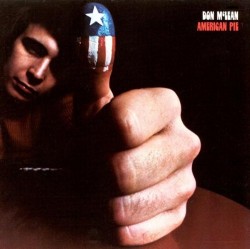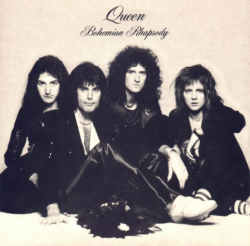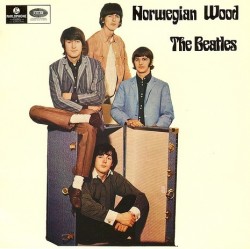SONG BENEATH THE SONG, which title I’ve purloined from the (fine) Maria Taylor tune of the same name, is an occasional feature in which we attempt to decode the meaning of popular song lyrics.
We kick off the feature on a tour of America, Bohemia, and Norway, with three of my all-time favorite tunes.
~
“American Pie”
Written by: Don McLean
Performed by: Don McLean
McLean’s magnum opus is a “dirge in the dark,” a song about the ramifications of the plane crash that claimed the life of Buddy Holly. Over the course of six verses, seven choruses, eight-and-a-half minutes, and any number of cryptic allusions approaching the Biblical in both scope and obscurity, the narrator inveighs against the British Invasion. The point is this: American music—viz., good music—died with Charles Harden Holley.
“The Day the Music Died” refers to 3 February, 1959 (“February made me shiver”), when Buddy Holly perished in a plane crash (“the plane climbed high into the night”), along with Ritchie Valens and The Big Bopper (neither worthy of mention in the song). When the chorus of “good ol’ boys” lament that “this’ll be the day that I die,” they are coyly alluding to Holly’s hit “That’ll Be The Day:”
You say you’re gonna leave
I know it’s a lie,
Cuz that’ll be the day-ay-ay
That I die.
Since the release of “American Pie” in November, 1971—just 12 years after the death of American music—listeners have played the roman à clef game, attempting to divine, often with the aid of mind-altering substances, just who the allegorical characters in the song are supposed to represent. Is “The King” Elvis, as is commonly assumed? Is “The Jester” Bob Dylan? The “girl who sang the blues” Janis Joplin? And who are the enigmatic “three men I admire most / the Father, Son, and Holy Ghost” who board the last train to California in the final verse? This tantalizing ambiguity is part of the song’s charm.
Whatever the meaning of the individual references, the chronological flow of the song seems clear. We begin at a dance in a high school gym, presumably early in ’59, as “The Book of Love” plays—the age of pink-carnation innocence, before the Lubbock sound was corrupted by Liverpudlians—and jump to ten years later (1969, a decade after Holly died), where the malefic influence of the Beatles (“the Sergeants played a marching tune,” “Lenin/Lennon read a book on Marx”), the Rolling Stones (“moss grows flat on a rolling stone,” “Jack Flash sat on a candlestick”), the Byrds (“the birds/Byrds flew off from the fallout shelter, eight miles high and falling fast”), and, curiously, the Grateful Dead (“fire is the devil’s only friend”) have adulterated the purity of American rock ‘n’ roll. We hit all the Baby Boom cultural milestones: the Manson murders (“helter skelter”), Woodstock (“and there we were in one place, a generation lost in space”), and Altamont (“no angel born in hell could break that Satan’s spell”), as well as the film Rebel Without a Cause (“a coat he borrowed from James Dean”).
In spite of all this generational excitement going on around him, however, the narrator is unmoved. Nothing—not the Beatles, not the “girl who sang the blues,” not even the Summer of Fucking Love—can make him forget the loss of Holly, whose memory he invokes with a reverence akin to religious zeal. If the three men he admires most (Hendrix, Morrison, and Clapton? Sinatra, Martin, and Sammy Davis Jr.? Nixon, Agnew, and Kissinger? Does McLean even know?) are the Father, Son, and the Holy Ghost, Holly, we might assume, is a trinity all to himself.
No one disputes the genius of Buddy Holly. Even the Beatles worshiped at his altar; the name of their band is meant to echo Holly’s own outfit, the Crickets. Just 23 when he died, Holly nevertheless left behind enough material to fill a solid greatest hits album. It could be argued—indeed, “American Pie” itself makes the argument—that his loss at such a young age is the single worst tragedy to befall the popular culture in the twentieth century. His untimely death deprived us of who knows how much great music. Or, to put it in Holly’s own words, “All my love, all my kissin’, you don’t know what you been missin’. Oh, boy.”
Nevertheless, I can’t help but find this song reactionary, a musical equivalent of Ron Paul reactionaries who want to “restore America.” I saw McLean perform when I was in high school—it was my first concert, in fact, back in ‘87—at the gym at Drew University (so he saw us dancing in the gym). I loved “American Pie” and “Superman’s Ghost” and “Vincent” and “Castles in the Air,” so I was excited for the show. McLean was not. At one point, he tore into Paul Simon, finger-picking a thirteenth chord and mockingly singing “At the Zoo.” It was uncomfortable, because his bitterness was so obvious. Basically, he came off like a jaded old man who hates anything new—you know, like the narrator of “American Pie.” That the cover of the album—McLean flashing the thumbs-up, with the American flag imprinted on his thumb—looks like a Tea Party political ad pretty much says it all.
Buddy’s gone, Don. Take a sad song and make it better.
~
“Bohemian Rhapsody”
Written by: Freddie Mercury
Performed by: Queen
Freddie Mercury’s backstory is as unique as any in the long annals of rock ‘n’ roll. Farrokh Bulsara was born on 5 September, 1946, in Zanzibar—then a British protectorate—to Bomi and Jer Bulsara, who hailed from the Gujarat province of India. They were Parsis, Zoroastrians who had fled Iran to avoid religious persecution a thousand years earlier. So Freddie came to the U.K. by way of East Africa by way of India by way of Persia—not the same as growing up blue-collar in a flat in Manchester.
He went to college, where he majored in art. He took a job selling secondhand clothes at Kensington Market. Although he was possessed of one of the finest pure singing voices ever bequeathed a mortal man—he could have out-Pavarotti’d Pavarotti—he had no formal vocal training. He was one of the best live performers to ever grace the stage. He named himself after a god. He was fastidiously, Pynchonesquely private, and became notorious for declining interviews. Although he had several relationships with women, he was, as he put it when asked, “as gay as a daffodil, my dear.” And when he died on 24 November, 1991, at the age of 42, it wasn’t because his plane went down, or he drank himself to death, or OD’d on smack, or choked on his own vomit—you know, the hackneyed rock star causes of death. Freddie died of bronchial pneumonia brought on by AIDS; he remains arguably the most famous person to die that way.
This is the guy who wrote “Bohemian Rhapsody,” which is understood to be some sort of personal statement. Not the easiest psyche to try and divine.
Like the Book of Revelations, “Bohemian Rhapsody” is, by design, confusing, strange, and seemingly nonsensical. Like the Book of Revelations, and again by design, it resists line-by-line analysis. If we invest our time trying to decipher every single word—Scaramouche? Fandango? Galileo Figaro?—we get nowhere. To properly divine the true meaning of the song, we must look at the composition as a whole—lyrics and music.
Many listeners take the song’s violent images at face value, believing that the plot, such as it is, concerns a murderer confessing to his crime. In a song that’s clearly intended to be allegorical, this is too simplistic an explanation, and it doesn’t square with the title—perhaps our most important clue. Bohemian indicates an unorthodox, artistic lifestyle; in 1975, when the song was released, it’s shorthand for gay. “Bohemian Rhapsody” is about Freddie Mercury a) coming out to his mother, and b) reconciling his own sexuality. The murderous imagery—the gun, the trigger, the killing—is a metaphor for active homosexual engagement (“put a gun against his head, pulled my trigger, now he’s dead”). When he sings, “Momma, I just killed a man,” he’s not disclosing that he killed a man, but that he “killed” a man.
In the first two verses of the song, he confesses to giving in to his homosexual impulses, which to him is a matter nothing short of life and death (“Life had just begun, and now I’ve gone and thrown it all away,” “I don’t want to die, sometimes wish I’d never been born at all”). He’s depressed, wistful, unsure of himself.
The mock-operatic bridge—and who but Mercury could pull that off so successfully?—represents Freddie wrestling with his inner demons. These are all voices in his head. Part of him is excited (“thunderbolts and lighting!”) by the “silhouetto of a man, Scaramouche,” and part of him beseeches the Almighty (Bismillah is the Islamic equivalent of “In the name of the Father, Son, and Holy Ghost,” or, “In the name of all things holy”) to “spare him his life from this monstrosity”—i.e., his preference for other guys. It is telling that the voices who “will not let [him] go” belong to the tenor, baritone, and bass parts. The females lobby for his release; it’s the men who have a hold on him.
He comes out of this tug-of-war resigned to his fate (“Beelzebub has a devil put aside for me!”), and as he repeats the end of this line, his voice climbing the seventh-chord notes (“For me! For me! For meeeeeeeeee!”)—and if this part of the song does not cause your spirits to soar, you are made of stone—he gradually accepts, and embraces, his sexuality.
During the song’s six minutes, he goes from a place of denial/fear (“I don’t want to die”), to a place of anger/indignation (“can’t do this to me, baby”), and after bargaining (“let me go!”), to a place of acceptance (“any way the wind blows,” cue: gong). It’s basically the Kübler-Ross model, set to some of the most glorious, complex, and beautiful music ever recorded by a rock band. A rock band, it must be said, called Queen.
~
“Norwegian Wood”
Written by: John Lennon, with help from Paul McCartney
Performed by: The Beatles
This, my favorite entry in the Beatles’ prodigious catalog, is one of the few “story songs” turned in by John Lennon (most of the others, from “Eleanor Rigby” to “Ob-la-di, Ob-la-da,” originate with Paul McCartney, who has a more Dickensian sensibility).
The story itself is straightforward: the narrator meets a girl, goes back to her apartment, drinks some wine, chats her up till two am, hoping to score—but doesn’t close the deal, winding up in the bathtub instead of her bed. This part, apparently, was John’s contribution to the tale:
“I was very careful and paranoid,” Lennon explained, “because I didn’t want my wife, Cyn, to know that there really was something going on outside of the household. I’d always had some kind of affairs going on, so I was trying to be sophisticated in writing about an affair. But in such a smoke-screen way that you couldn’t tell.”
The next morning, the more ambiguous shit goes down:
And when I awoke,
I was alone:
This bird had flown.
So I lit a fire.
Isn’t it good?
Norwegian wood.
A literal reading suggests that the narrator woke up angry and burned her wooden furniture. No less an authority than McCartney, whose idea this was, confirms this:
The girl “makes [the narrator] sleep in the bath and then finally in the last verse I had this idea to set the Norwegian wood on fire as revenge, so we did it very tongue in cheek,” Paul said. “She led him on, then said, ‘You’d better sleep in the bath.’ In our world the guy had to have some sort of revenge…so it meant I burned the place down.”
Not to suggest that the guy who wrote the song is full of shit, but the guy who wrote the song is full of shit. This business about the literal burning of the Norwegian wood is just a smoke-screen (and a good one, because pine burns like a motherfucker). We know it’s a smoke-screen, because if you read the quotes again, Lennon says as much.
First of all, there’s no furniture to burn. When she first tells him to sit down, remember, he “looked around and [he] noticed there wasn’t a chair.” Does he strip the paneling from the wall and burn that? What sense does that make?
Let’s say you’re a dude—let’s say you’re John Lennon, even—and this scenario happens to you, just as described. You’re invited back to some “bird’s” apartment; she goes so far as to give you a tour of her boudoir. You’re like, Dig it! Isn’t it good? You might say you want to hold her hand, but what you really want to do is come together. You drink a bottle of wine, you shoot the shit till the wee hours… but she’s a big teaser, she takes you half the way there. You wake up in the bathtub, with a crink in your neck and a hard-on in your trousers so unrelentingly thick it feels like a piece of—yes!—Norwegian wood. You get up to look for her, hoping she’ll help you carry that weight, but the girl that’s driving you mad has gone away. Then you recall her saying something about having to work in the morning, as a sort of bullshit excuse, and laughing in your face. And it hits you: you and your hard-on have the place to yourself.
That’s what’s happened, Mr. Rock Star. That’s the dealio. So do you a) engineer some way to torch her wood-paneled room, resulting in a massive conflagration that may well kill everyone in the apartment building and land you in jail—or gaol, as they say in the UK—for arson, or b) rub one out?
“Lit a fire,” it says here, is a euphemism for masturbation—and a pretty good one, when you consider that a) lust is traditionally equated with fire, and b) rubbing two sticks together is not dissimilar to the process of manual stimulation (the movement you need is on your shoulder).
Does our narrator leave her home in ashes because she ignored his pleas to please please him? No, but he does leave his goo-goo-ga-joob as a souvenir. All you need is love, yes, but in the end, the love you take is equal to the love you make.





